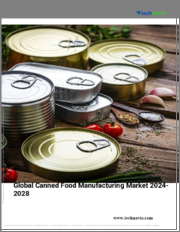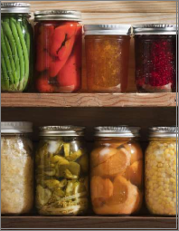
|
시장보고서
상품코드
1666076
통조림 식품 시장 규모, 점유율, 성장 분석 : 제품별, 유형별, 유통 채널별, 지역별 - 산업 예측(2025-2032년)Canned Food Market Size, Share, and Growth Analysis, By Product (Canned Fruits & Vegetables, Canned Meat Products), By Type (Organic, Conventional), By Distribution Channel, By Region - Industry Forecast 2025-2032 |
||||||
통조림 식품 시장 규모는 2023년 845억 달러로 평가되며, 예측 기간(2025-2032년) 동안 5.2%의 CAGR로 2024년 888억 9,000만 달러에서 2032년 1,333억 5,000만 달러로 성장할 것으로 예상됩니다.
통조림 식품 시장은 편리하고 보존성이 높은 제품에 대한 소비자 수요 증가로 인해 큰 성장이 예상됩니다. 바쁜 라이프스타일로 인해 가족과 개인은 번거롭지 않은 식사 해결책을 찾게 되었고, 최소한의 조리 과정과 긴 유통기한을 가진 통조림 식품이 점점 더 매력적으로 다가오고 있습니다. 통조림의 인기는 냉장 시설이 부족한 캠핑이나 하이킹과 같은 야외 활동에도 영향을 받고 있습니다. 또한 맞벌이 증가로 인한 가족 구성의 변화, 비상시 대비에 대한 관심의 증가도 조리된 식품 시장을 강화시키고 있습니다. 통조림 기술의 발전, 포장 방법의 개선, 지속가능한 관행으로의 전환은 건강 지향적인 소비자들을 더욱 끌어들이고 있으며, 통조림 식품 부문이 오늘날의 급변하는 세계에서 관련성을 확고히 하고 있습니다.
목차
소개
- 조사 목적
- 조사 범위
- 정의
조사 방법
- 정보 조달
- 2차와 1차 데이터 방법
- 시장 규모 예측
- 시장 가정과 제한
주요 요약
- 세계 시장 전망
- 공급과 수요 동향 분석
- 부문별 기회 분석
시장 역학과 전망
- 시장 개요
- 시장 규모
- 시장 역학
- 성장 촉진요인과 기회
- 성장 억제요인과 과제
- Porters 분석
주요 시장 인사이트
- 핵심성공요인
- 경쟁 정도
- 주요 투자 기회
- 시장 생태계
- 시장 매력 지수(2024년)
- PESTEL 분석
- 거시경제 지표
- 밸류체인 분석
- 가격 분석
통조림 식품 시장 규모 : 제품별
- 시장 개요
- 통조림 과일과 야채
- 통조림 육제품
- 통조림 해산물
- 통조림 즉석식품
- 통조림 조미료
- 기타
통조림 식품 시장 규모 : 유형별
- 시장 개요
- 유기농
- 기존
통조림 식품 시장 규모 : 유통 채널별
- 시장 개요
- 푸드서비스
- 소매
- 하이퍼마켓과 슈퍼마켓
- 편의점
- 온라인
- 기타
통조림 식품 시장 규모
- 북미
- 미국
- 캐나다
- 유럽
- 독일
- 스페인
- 프랑스
- 영국
- 이탈리아
- 기타 유럽
- 아시아태평양
- 중국
- 인도
- 일본
- 한국
- 기타 아시아태평양
- 라틴아메리카
- 브라질
- 기타 라틴아메리카
- 중동 및 아프리카
- GCC 국가
- 남아프리카공화국
- 기타 중동 및 아프리카
경쟁 정보
- 상위 5개사의 비교
- 주요 기업의 시장 포지셔닝(2024년)
- 주요 시장 기업이 채용한 전략
- 최근의 시장 동향
- 기업의 시장 점유율 분석(2024년)
- 주요 기업 개요
- 기업 상세
- 제품 포트폴리오 분석
- 기업 부문별 점유율 분석
- 매출 전년비 비교(2022-2024년)
주요 기업 개요
- Campbell Soup Company(USA)
- Conagra Brands(USA)
- Del Monte Foods(USA)
- General Mills(USA)
- Hormel Foods Corporation(USA)
- Kraft Heinz Company(USA/Netherlands)
- Nestle S.A.(Switzerland)
- Unilever(UK/Netherlands)
- JBS S.A.(Brazil)
- Thai Union Group(Thailand)
- Bolton Group(Italy)
- Princes Limited(UK)
- Bonduelle(France)
- Libby's(USA)
- Crown Holdings, Inc.(USA)
- Bumble Bee Seafoods(USA)
- Goya Foods(USA)
- Ayam Brand(Singapore)
- Clover Leaf Seafoods(Canada)
- Rhodes Food Group(South Africa)
결론과 제안
ksm 25.04.03Canned Food Market size was valued at USD 84.5 billion in 2023 and is poised to grow from USD 88.89 billion in 2024 to USD 133.35 billion by 2032, growing at a CAGR of 5.2% during the forecast period (2025-2032).
The canned food market is poised for significant growth, driven by rising consumer demand for convenient, preservative-rich products. As busy lifestyles force families and individuals to seek effortless meal solutions, canned foods become increasingly appealing due to their minimal preparation requirements and long shelf life. Their popularity is also bolstered by outdoor activities like camping and hiking, where refrigeration is scarce. Additionally, changing family dynamics with more working individuals and a growing focus on emergency preparedness enhance the market for ready-to-eat meals. Advancements in canning technology, improved packaging methods, and a shift toward sustainable practices further attract health-conscious consumers, solidifying the canned food sector's relevance in today's fast-paced world.
Top-down and bottom-up approaches were used to estimate and validate the size of the Canned Food market and to estimate the size of various other dependent submarkets. The research methodology used to estimate the market size includes the following details: The key players in the market were identified through secondary research, and their market shares in the respective regions were determined through primary and secondary research. This entire procedure includes the study of the annual and financial reports of the top market players and extensive interviews for key insights from industry leaders such as CEOs, VPs, directors, and marketing executives. All percentage shares split, and breakdowns were determined using secondary sources and verified through Primary sources. All possible parameters that affect the markets covered in this research study have been accounted for, viewed in extensive detail, verified through primary research, and analyzed to get the final quantitative and qualitative data.
Canned Food Market Segments Analysis
Global Canned Food Market is segmented by Product, Type, Distribution Channel and region. Based on Product, the market is segmented into Canned Fruits & Vegetables, Canned Meat Products, Canned Fish/ Seafoods, Canned Ready Meals, Canned Condiments and Others. Based on Type, the market is segmented into Organic and Conventional. Based on Distribution Channel, the market is segmented into Food service and Retail. Based on region, the market is segmented into North America, Europe, Asia Pacific, Latin America and Middle East & Africa.
Driver of the Canned Food Market
The growth of the global canned food market can be significantly attributed to the rise in urban populations and increasing economic activities. As more people move to cities, the demands of longer work hours create a greater need for convenient, ready-to-eat food options. Canned foods meet this demand exceptionally well, as they offer quick meal solutions that require minimal preparation and align with health-conscious choices. This trend towards urbanization not only influences lifestyle changes but also enhances the appeal of canned foods, making them an essential part of modern diets for busy individuals seeking efficiency without compromising on nutrition.
Restraints in the Canned Food Market
Concerns regarding the safety of canned foods have significantly hindered the growth of the global canned food market, leading consumers to increasingly prioritize health-conscious choices. Research has indicated that fast food consumption is linked to obesity and various health issues, prompting a shift towards healthier options, such as fast-casual dining. This change is largely driven by health-conscious consumers, who are wary of the processing chemicals and preservatives commonly found in canned products. As a result, more individuals are opting for alternatives that promise fresher, less processed ingredients, ultimately reshaping consumer preferences and posing challenges for the canned food industry.
Market Trends of the Canned Food Market
The canned food market is witnessing a dynamic trend fueled by significant advancements in product innovation and canning technology. Enhanced canning techniques have elevated the overall quality, taste, and nutritional profile of canned foods, aligning them with the preferences of health-conscious consumers. The introduction of BPA-free packaging, reductions in sodium levels, and the incorporation of organic and non-GMO ingredients are broadening the market's reach and appeal. This shift not only caters to evolving consumer demands for cleaner, healthier options but also positions canned foods as a convenient and safe choice, thereby driving growth in this evolving market landscape.
Table of Contents
Introduction
- Objectives of the Study
- Scope of the Report
- Definitions
Research Methodology
- Information Procurement
- Secondary & Primary Data Methods
- Market Size Estimation
- Market Assumptions & Limitations
Executive Summary
- Global Market Outlook
- Supply & Demand Trend Analysis
- Segmental Opportunity Analysis
Market Dynamics & Outlook
- Market Overview
- Market Size
- Market Dynamics
- Drivers & Opportunities
- Restraints & Challenges
- Porters Analysis
- Competitive rivalry
- Threat of substitute
- Bargaining power of buyers
- Threat of new entrants
- Bargaining power of suppliers
Key Market Insights
- Key Success Factors
- Degree of Competition
- Top Investment Pockets
- Market Ecosystem
- Market Attractiveness Index, 2024
- PESTEL Analysis
- Macro-Economic Indicators
- Value Chain Analysis
- Pricing Analysis
Global Canned Food Market Size by Product & CAGR (2025-2032)
- Market Overview
- Canned Fruits & Vegetables
- Canned Meat Products
- Canned Fish/ Seafoods
- Canned Ready Meals
- Canned Condiments
- Others
Global Canned Food Market Size by Type & CAGR (2025-2032)
- Market Overview
- Organic
- Conventional
Global Canned Food Market Size by Distribution Channel & CAGR (2025-2032)
- Market Overview
- Food service
- Retail
- Hypermarkets & Supermarkets
- Convenience Stores
- Online
- Others
Global Canned Food Market Size & CAGR (2025-2032)
- North America (Product, Type, Distribution Channel)
- US
- Canada
- Europe (Product, Type, Distribution Channel)
- Germany
- Spain
- France
- UK
- Italy
- Rest of Europe
- Asia Pacific (Product, Type, Distribution Channel)
- China
- India
- Japan
- South Korea
- Rest of Asia-Pacific
- Latin America (Product, Type, Distribution Channel)
- Brazil
- Rest of Latin America
- Middle East & Africa (Product, Type, Distribution Channel)
- GCC Countries
- South Africa
- Rest of Middle East & Africa
Competitive Intelligence
- Top 5 Player Comparison
- Market Positioning of Key Players, 2024
- Strategies Adopted by Key Market Players
- Recent Developments in the Market
- Company Market Share Analysis, 2024
- Company Profiles of All Key Players
- Company Details
- Product Portfolio Analysis
- Company's Segmental Share Analysis
- Revenue Y-O-Y Comparison (2022-2024)
Key Company Profiles
- Campbell Soup Company (USA)
- Company Overview
- Business Segment Overview
- Financial Updates
- Key Developments
- Conagra Brands (USA)
- Company Overview
- Business Segment Overview
- Financial Updates
- Key Developments
- Del Monte Foods (USA)
- Company Overview
- Business Segment Overview
- Financial Updates
- Key Developments
- General Mills (USA)
- Company Overview
- Business Segment Overview
- Financial Updates
- Key Developments
- Hormel Foods Corporation (USA)
- Company Overview
- Business Segment Overview
- Financial Updates
- Key Developments
- Kraft Heinz Company (USA/Netherlands)
- Company Overview
- Business Segment Overview
- Financial Updates
- Key Developments
- Nestle S.A. (Switzerland)
- Company Overview
- Business Segment Overview
- Financial Updates
- Key Developments
- Unilever (UK/Netherlands)
- Company Overview
- Business Segment Overview
- Financial Updates
- Key Developments
- JBS S.A. (Brazil)
- Company Overview
- Business Segment Overview
- Financial Updates
- Key Developments
- Thai Union Group (Thailand)
- Company Overview
- Business Segment Overview
- Financial Updates
- Key Developments
- Bolton Group (Italy)
- Company Overview
- Business Segment Overview
- Financial Updates
- Key Developments
- Princes Limited (UK)
- Company Overview
- Business Segment Overview
- Financial Updates
- Key Developments
- Bonduelle (France)
- Company Overview
- Business Segment Overview
- Financial Updates
- Key Developments
- Libby's (USA)
- Company Overview
- Business Segment Overview
- Financial Updates
- Key Developments
- Crown Holdings, Inc. (USA)
- Company Overview
- Business Segment Overview
- Financial Updates
- Key Developments
- Bumble Bee Seafoods (USA)
- Company Overview
- Business Segment Overview
- Financial Updates
- Key Developments
- Goya Foods (USA)
- Company Overview
- Business Segment Overview
- Financial Updates
- Key Developments
- Ayam Brand (Singapore)
- Company Overview
- Business Segment Overview
- Financial Updates
- Key Developments
- Clover Leaf Seafoods (Canada)
- Company Overview
- Business Segment Overview
- Financial Updates
- Key Developments
- Rhodes Food Group (South Africa)
- Company Overview
- Business Segment Overview
- Financial Updates
- Key Developments



















